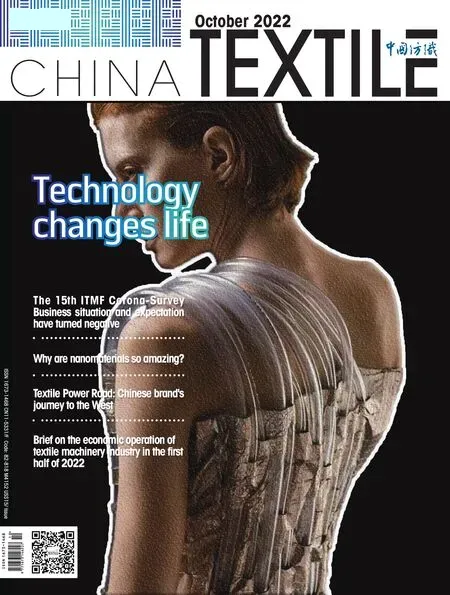Sun-protective clothing market expected to reach 95.8 billion yuan in 2026
By Zhao Xinhua

In the scorching summer,preventing ultraviolet rays from harming the human body has been valued by more and more consumers.UV protection cloth—ing and textiles such as sun protection clothing and umbrellas have become essential.According to CIC data,the market size of China's sunscreen apparel increased from 45.9 billion yuan in 2016 to 61.1 bil—lion yuan in 2021,and is expected to reach 95.8 bil—lion yuan in 2026.
UPF is short for Ultraviolet Protection Factor,which means the ability of a fabric to protect against Ultraviolet rays.The UV Protection Factor (UPF) spec—ifies how much longer the user of sunscreen textiles or the wearer of UV protection clothing can stay in the sun without causing skin damage.
This definition is abstract,so we can understand the physical meaning of the UPF in this way.For ex—ample,a UPF value of 50 means that 1/50 of the ul—traviolet light can pass through the fabric.The higher the UPF value,the better the UV protection.However,the highest UPF value of textiles in the national stan—dard is 50+,that is,UPF>50.Because when the UPF is greater than 50,the impact on the human body is completely negligible.A UPF 50 garment allows about 1/50 (about 2%) UV transmission.Any fabric with a UV transmittance below 2% is marked UPF 50+.Fabrics below UPF 15 do not provide UV protec—tion.For example,a regular white cotton T—shirt has a UPF rating of about 5.
UPF is referred to as the ultraviolet protection factor.A fabric with an UPF>40 is considered to pro—vide excellent protection against UV radiation.UV protective treatment is given to industrial fabrics for awnings,canopies,tents and blinds. Lightweight knitted and woven fabrics should be combined with UV protective finishes to have products like shirts,blouses,T shirts,swimwear,sportswear,etc.as the most exposure to the sun is during the summers.Protection of the skin against the action of solar ra—diation is a relatively new objective of textile finishing.When radiation strikes a fiber surface,it can be re—flected,absorbed or transmitted through the fiber or pass between fibers.
Polyester is the best chemical fiber for sun pro—tection,while flax is the best natural fiber.Polyester fiber has the best ultraviolet resistance,which is re—lated to the absorption function of the benzene ring in the molecular structure of polyester fiber.Nylon,cotton,silk anti—ultraviolet performance is not very satisfactory.Therefore,the choice of UV protection clothing should try to choose polyester fiber fabric.(Now some domestic polyester fiber fabric UV protec—tion performance has reached a very high level).
At present,most of the UV protection textiles are on the market by in textiles dyeing with UV protection textile finishing agent or by immersion or padding to UV treatment fluid effect,but these methods of compatibility between all kinds of dyes,auxiliaries put forward very high requirements,and the color of the dye caused certain pressure control and emissions of waste water treatment.There will be some impact on the environment.In addition,with the increasing demand for lightweight clothing,ultra—fine denierfiber fabric UV prevention technology has also been put forward as a topic,but ultra—fine denier fiber fabric in dyeing bath or dip rolling liquid,the amount of resin absorption and effective ingredi—ents are limited,resulting in the general effect of UV prevention.
Use of bio—colorants is a very old practice to make the apparel attractive.They were used prevalently before the invention of synthetic dyes and pigments.Most bio—colorants are obtained from different parts of a plant,namely,flowers,fruits,seeds,leaves,barks,trunks,and roots,or through extraction of the dried bodies of insects.Thus,bio—colorants are cheap and eco—friendly.Recently,researchers have been using natural dyes to improve UPF.Researchers have found that a number of natural dyes could improve the UPF of linen and hemp fabrics.Extraction of the eucalyptus leaf and Flos Sophorae can be used to improve the UPF property of silk fibers.We used madder (Rubia cordifolia) and cutch (Acacia cate—chu) to improve the UPF of nettle fabric.Very re—cently,according to the report that dye extraction from the fruit shell waste of Sterculia foetida has very good potential to improve the UPF of linen fabric.Thus,it can be concluded that sustainable wastage materials are useful to improve the UPF of textile fabrics.
After finishing with anti—ultraviolet fabric,it is non—toxic,no irritation to skin,no allergic reaction,and does not affect the color,strength and moisture absorption of the fabric.Due to its light weight,soft feel and easy cleaning,this kind of clothing is easy and comfortable to wear,and has strong water ab—sorption capacity,air permeability and certain wind resistance,so that the wearer can maintain the best state of exercise in outdoor activities.

